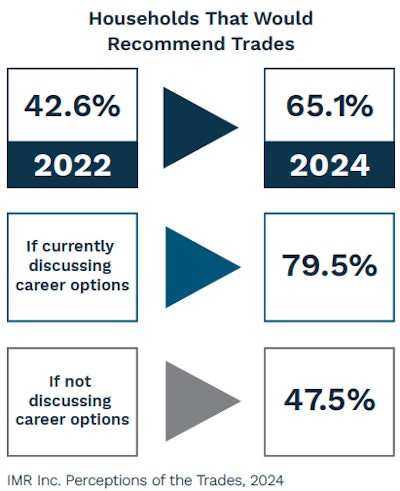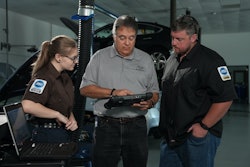
Four-year colleges and universities remain the most popular higher education and career path recommendation by U.S. households for their children, but support for trade programs also is on the rise — a welcome sign for industry and career and technical education (CTE).
According to a spring 2024 survey of American households with high school-aged children by automotive market research firm IMR Inc., the percentage of households who would recommend a trade to a child considering a future career rose to 65.1% last year, up from 42.6% in 2022. Among households where a family member or friend is already employed in a trade, that number rose even higher to 72.8%, up 8.2% from 2022.
Both numbers showcase the continuing acceptance of CTE programs among modern parents as a great path forward for their children.
“When looking at things like stability, earning potential, opportunities for advancement, ongoing learning to keep employability skills sharp and career choices, the trades have always performed well,” says Dave Johnson, ASE president and CEO. “The current movement toward choosing a STEM career represents a growing awareness of just how many options there are to reach success for those working in or considering a career in the automotive industry.
“The demand for technical talent will continue to grow, but the greatest opportunities will be available to those with the drive and determination to keep their skills comprehensive and current. That’s true for both CTE and any other career choice.”
The improving perception of trades among parents can be seen throughout IMR’s survey.
Among households discussing career options with a child, a four-year college or university remains the most commonly recommended path forward at 51.6%, but a trade school is a clear runner up at 24.2%. When discussing all options, households reference trade schools at an even higher percentage (25.1%), while 87.4% suggest a trade to children who are eager to enter the workforce immediately.
And support for trade schools is not limited to households with trade experience.

Within households that have completed some college education, trade school was actually recommended at a slightly higher rate (49.3% to 48.8%) than a four-year college in 2024.
“It shouldn’t be surprising that parents in particular are viewing the trades more favorably when talking with their children.” Johnson says. “Many of them have seen their white-collar peers face downsizing as skillsets become less important due to changing technology, while the technician who services the family car was being declared an essential employee during the pandemic.”
On an industry basis, aircraft maintenance/repair received the strongest support among households in IMR’s study, with 54.6% stating they would recommend the trade to a child. Automotive technician followed at 46.1% with heavy-duty/diesel technician several industries behind at 34.8%.
Drilling down into the automotive sentiment, IMR’s survey indicates shifting household perceptions around technical labor as driving factor toward increased household support.

Nearly 43% of households today believe the cost of completing education to be an automotive technician is “significantly less” than a traditional college education; another 45% believe the earning opportunities for auto technicians can be equal to or more than other careers where a four-year degree is required. IMR writes, “younger generations are more likely to agree with this statement than older generations.”
ASE says these perception shifts are vital to the sustainability of the automotive service channel and believe cooperation between educators and industry can do the same to help alleviate trucking’s employment challenges.
[RELATED: What stops tech students from pursuing tech careers?]
“It’s important to note also that parents are the primary influencers on children when thinking about a career,” says Mike Coley, president of the ASE Education Foundation. “The ASE Education Foundation actually members of their advisory committees to make sure their input and experience is included in the mix.”
But IMR’s survey also shows much progress can still be made. Only 38.3% of households in 2024 strongly disagreed with the statement that working as an automotive technician is “a job and not a viable career path;” a third also believed technicians are often portrayed negatively. Both numbers indicate the challenges trades must continue to overcome in mainstream culture to be viewed on an equivalent plane with four-year college programs.
“In talking with our field managers, it’s often noted that some parents are surprised when learning more about the choices, opportunities and advantages of a career in the automotive industry,” says Johnson. “While we have more work to do on communicating just how rewarding and fulfilling a CTE career can be in the automotive industry, many of the old perceptions are changing in the face of advancing automotive technology that looks a lot more like network engineering than oil changes.
“ASE and the ASE Education Foundation were created to support and help improve the image of automotive, truck, and collision repair professionals through certification and program accreditation. The data we have show it’s working when they gear up!”
Next up: Part VI of our special report, ‘High schoolers love tech classes, unsure about tech careers.’











